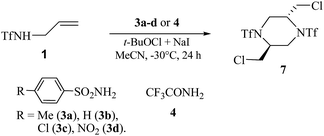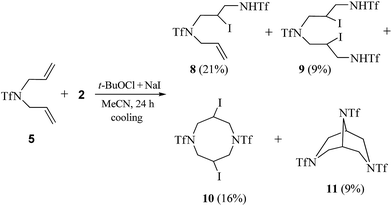 Open Access Article
Open Access ArticleCreative Commons Attribution 3.0 Unported Licence
Oxidative addition/cycloaddition of arenesulfonamides and triflamide to N-allyltriflamide and N,N-diallyltriflamide†
B. A. Shainyan *,
V. V. Astakhova,
A. S. Ganin,
M. Yu Moskalik and
I. V. Sterkhova
*,
V. V. Astakhova,
A. S. Ganin,
M. Yu Moskalik and
I. V. Sterkhova
A. E. Favorsky Irkutsk Institute of Chemistry, Siberian Division of Russian Academy of Sciences, 1 Favorsky Street 664033, Irkutsk, Russia. E-mail: bagrat@irioch.irk.ru
First published on 9th August 2017
Abstract
N-Allyltriflamide adds triflamide in the oxidative system (t-BuOCl + NaI) to give N,N′,N′′-propane-1,2,3-triyltris(triflamide), while under the same conditions arenesulfonamides as well as trifluoroacetamide diastereoselectively give the product of chlorination/dimerization, (2R,5S)-2,5-bis(chloromethyl)-1,4-bis[(trifluoromethyl)sulfonyl]piperazine. N,N-Diallyltriflamide reacted with triflamide affords the products of iodotriflamidation of one or two C![[double bond, length as m-dash]](https://www.rsc.org/images/entities/char_e001.gif) C bonds, and the product of intramolecular iodotriflamidation, 3,7-diiodo-1,5-bis[(trifluoromethyl)sulfonyl]-1,5-diazocane, and 3,7,9-tris[(trifluoromethyl)sulfonyl]-3,7,9-triazabicyclo[3.3.1]nonane. In contrast, with arenesulfonamides and trifluoroacetamide, N,N-diallyltriflamide gives the products of iodoamidation or/and iodochlorination at only one double bond.
C bonds, and the product of intramolecular iodotriflamidation, 3,7-diiodo-1,5-bis[(trifluoromethyl)sulfonyl]-1,5-diazocane, and 3,7,9-tris[(trifluoromethyl)sulfonyl]-3,7,9-triazabicyclo[3.3.1]nonane. In contrast, with arenesulfonamides and trifluoroacetamide, N,N-diallyltriflamide gives the products of iodoamidation or/and iodochlorination at only one double bond.
Introduction
The chemistry of triflamide (CF3SO2NH2 or TfNH2) and its derivatives has attracted the attention of chemists due to its high acidity, catalytic activity1 and specific chemical properties which are different from those of other sulfonamides, as was clearly demonstrated in our review.2 Of special interest are unsaturated derivatives of triflamide, because the presence of a multiple bond affected by a very strong electron-acceptor triflyl group increases the synthetic potential of these compounds. Until recently, very scarce information was available not only on unsaturated triflamide compounds but also for other sulfonamides as well. The first representative of N-alkenyltriflamides was synthesized by us in 2012.3 Since then, numerous unsaturated triflamide compounds having one or two double or/and triple bonds have been synthesized and investigated in different reactions.4Another fascinating field of the triflamide chemistry is the reactions of oxidative triflamidation of alkenes and dienes, leading in many cases to the products different from those obtained with arenesulfonamides.5 A similar specific reactivity was observed in the reactions of oxidative trifluoroacetamidation in comparison with the reactions of non-fluorinated amides.6 However, depending on the substrate and the oxidant, triflamide may show the same pattern of reactivity as arenesulfonamides, like it was demonstrated very recently on the example of chloroamidation of a large series of indoles with triflamides and arenesulfonamides with NaClO as an oxidant.7 In all cases, the products of substitution (via addition–elimination), 3-chloro-2-amidoindoles, were obtained in moderate to excellent yields.
It was reasonable to assume that the study of the reactions combining these two types of transformations, that is, the reactions of oxidative triflamidation of unsaturated triflamide derivatives, would lead to new unusual structures and specific patterns of reactivity. With this in mind, in the present study we have studied the reactions of N-allyltriflamide TfNHCH2CH![[double bond, length as m-dash]](https://www.rsc.org/images/entities/char_e001.gif) CH2 1 with triflamide 2 and, for comparison, with arenesulfonamides 4-RC6H4SO2NH2 (R = Me, H, Cl, NO2) 3a–d and trifluoroacetamide 4 under oxidative conditions in the system (t-BuOCl + NaI). The reaction of N,N-diallyltriflamide TfN(CH2CH
CH2 1 with triflamide 2 and, for comparison, with arenesulfonamides 4-RC6H4SO2NH2 (R = Me, H, Cl, NO2) 3a–d and trifluoroacetamide 4 under oxidative conditions in the system (t-BuOCl + NaI). The reaction of N,N-diallyltriflamide TfN(CH2CH![[double bond, length as m-dash]](https://www.rsc.org/images/entities/char_e001.gif) CH2)2 5 with triflamide has also been studied to investigate the effect of the substrate on the course of the reaction.
CH2)2 5 with triflamide has also been studied to investigate the effect of the substrate on the course of the reaction.
The reaction of N-allyltriflamide with triflamide at −30 °C proceeds in quantitative yield and affords a single product identified as N,N′,N′′-propane-1,2,3-triyltris(triflamide) 6 (Fig. 1). The structure of product 6 was proved by 1H, 13C, 19F NMR and IR spectroscopy and elemental analysis (Scheme 1).
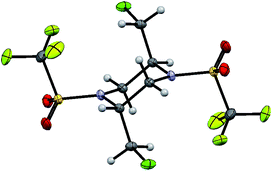 | ||
| Fig. 1 ORTEP diagram of (2R,5S)-2,5-bis(chloromethyl)-1,4-bis[(trifluoromethyl)sulfonyl]piperazine 7.9 | ||
For comparison, we performed under the same conditions the reaction of N-allyltriflamide 1 with arenesulfonamides 3a–d (R = Me, H, Cl, NO2) and with trifluoroacetamide CF3CONH2 4. To our surprise, for the reaction both with 3 and with 4 the only product isolated in good yield was piperazine 7. That means, that both arenesulfonamides and trifluoroacetamide act only as chlorine carriers, irrespective of their NH-acidity, which is much lower than that of triflamide (pKa vary from 11.70 for 3a to 9.48 for 3d and are equal to and 6.39 for TfNH2 and >14 for 4). However, the yield tends to increase with the decrease of pKa of the amide (Table 1).
| Entry | X | Conversion | Yieldb (%) |
|---|---|---|---|
| a Reaction conditions: 8 mmol of 1, 8 mmol of 3a–d or 4, 24 mmol of NaI, 24 mmol of t-BuOCl in 80 ml of CH3CN was stirred for 24 h at −30 °C in argon atmosphere in the dark.b Isolated yields. | |||
| 1 | MeC6H4SO2 | 70 | 50 |
| 2 | C6H5SO2 | 51 | 76 |
| 3 | ClC6H4SO2 | 43 | 53 |
| 4 | NO2C6H4SO2 | 69 | 86 |
| 5 | CF3CO | 64 | 46 |
The structure of product 7 was deduced from its IR, mass, 1H and 13C NMR spectra, in particular, from the absence of NH signals in 1H NMR as well as ν NH band in IR spectrum, the presence of two pairs of diastereotopic methylene protons in the range 3.6–4.1 ppm, with respect to one unresolved multiplet of methine proton at 4.25 ppm, and the corresponding 13C signals at 40, 42 and 55 ppm as well as one CF3 quartet at 120 ppm. The mass spectrum showed a low-intense peak of molecular ion with m/z 446 and most intense ions with m/z 397 [M − CH2Cl] and 263 [M − CF3SO2 − HCl], all with proper isotope distribution. Finally, the molecular structure was determined by single crystal X-ray analysis as (2R,5S)-2,5-bis(chloromethyl)-1,4-bis[(trifluoromethyl)sulfonyl]piperazine 7 (Fig. 1).8 Molecule 7 has S2 mirror-rotation axis (or inversion centre Ci) passing through the center of the ring and parallel to the S–CF3 and C–CH2Cl bonds.
It is worth noting that N-allylamides with other electron-withdrawing groups like Ts, PhCO or PhCS, show essentially different behaviour: in the same oxidative system they undergo intramolecular cyclization with the formation of 2-iodomethyl-N-tosylaziridine, 5-iodomethyl-2-phenylisoxazole or -thiazole, respectively.10 This means that, as in many other cases, unsaturated triflamide 1 exhibit specific reactivity which is distinct from that of other sulfonamides in similar reactions. The reasons for that were outlined by us earlier.2
Under the same conditions, N,N-diallyltriflamide 5 gives a whole bunch of linear and cyclic products in a moderate total yield and in comparable amounts depending on the reaction conditions (Scheme 3). With equimolar ratio of the reagents at −10 °C, the reaction mixture contains monoadduct 8, 3,7-diiodo-1,5-bis(trifluoromethylsulfonyl)-1,5-diazocane 10 and 3,7,9-tris(trifluoromethylsulfonyl)-3,7,9-triazabicyclo[3.3.1]nonane 11, along with a small amount of unreacted substrate 5. Increasing the ratio of 5 to 2 to 1![[thin space (1/6-em)]](https://www.rsc.org/images/entities/char_2009.gif) :
:![[thin space (1/6-em)]](https://www.rsc.org/images/entities/char_2009.gif) 2 and carrying out the reaction at −30 °C results in full conversion of the reagents and formation of diadduct 9, apart from products 8, 10, 11. All reaction products were isolated as individual compounds by column chromatography and their structure was determined by 1H, 13C, 19F NMR spectroscopy and, for compounds 10 and 11, also by single crystal X-ray analysis, Fig. 2 and 3, respectively. Molecule 10 has C2 symmetry axis, and molecule 11 has the plane of symmetry passing through the sulfur and nitrogen atoms.
2 and carrying out the reaction at −30 °C results in full conversion of the reagents and formation of diadduct 9, apart from products 8, 10, 11. All reaction products were isolated as individual compounds by column chromatography and their structure was determined by 1H, 13C, 19F NMR spectroscopy and, for compounds 10 and 11, also by single crystal X-ray analysis, Fig. 2 and 3, respectively. Molecule 10 has C2 symmetry axis, and molecule 11 has the plane of symmetry passing through the sulfur and nitrogen atoms.
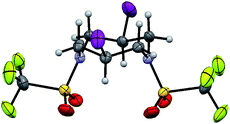 | ||
| Fig. 2 ORTEP diagram of 3,7-diiodo-1,5-bis(trifluoromethylsulfonyl)-1,5-diazocane 10.11 | ||
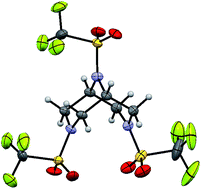 | ||
| Fig. 3 ORTEP diagram of 3,7,9-tris(trifluoromethylsulfonyl)-3,7,9-triazabicyclo[3.3.1]nonane 11.12 | ||
As with N-allyltriflamide 1, we performed the reaction of N,N-diallyltriflamide 5 with arenesulfonamides 3a–d and with trifluoroacetamide CF3CONH2 4. The reaction occurred only at one double bond leading to the products of iodoamidation 12 similar to 8, and their isoelectronic analogue 13 (Table 2). No addition to the second C![[double bond, length as m-dash]](https://www.rsc.org/images/entities/char_e001.gif) C bond takes place even with double excess of sulfonamide (on the example of NO2C6H4SO2NH2). The reasons for such inertness of the second double bond in 5 with respect to addition of sulfonamides are not clear; the only assumption is that the oxidative addition to one double bond decreases the reactivity with respect to further reaction with electrophiles, which may require harsher conditions, in which the reaction mixture undergoes resinification.
C bond takes place even with double excess of sulfonamide (on the example of NO2C6H4SO2NH2). The reasons for such inertness of the second double bond in 5 with respect to addition of sulfonamides are not clear; the only assumption is that the oxidative addition to one double bond decreases the reactivity with respect to further reaction with electrophiles, which may require harsher conditions, in which the reaction mixture undergoes resinification.
| Entry | X | Conversion | Yieldb (%) | |
|---|---|---|---|---|
| 12 | 13 | |||
| a Reaction conditions: 7 mmol of 5, 7 mmol of 3a–d or 4, 20 mmol of NaI, 20 mmol of t-BuOCl in 50 ml of CH3CN was stirred for 24 h at −30 °C in argon atmosphere in the dark.b Isolated yields taking into account the conversion. | ||||
| 1 | MeC6H4SO2 | 25 | 42 | — |
| 2 | C6H5SO2 | 41 | 29 | 41 |
| 3 | ClC6H4SO2 | 45 | — | 43 |
| 4 | NO2C6H4SO2 | 44 | — | 42 |
| 5 | CF3CO | 67 | 31 | — |
One-pot assembling of 1,5-diazocane and 3,7,9-triazabicyclo[3.3.1]nonane scaffolds shown in Scheme 3 is of interest because it was shown that the presence of the 1,5-diazocane motif in oxidative polyamine metabolites is critical for inhibiting activity and suppressing cytotoxicity.13 The known methods of synthesis of 1,5-diazacyclooctanes suffer from costly reagents14 or long-term processes (up to nine days).15 The present work provides the first one-pot synthesis of 3,7-diiodo-1,5-bis[(trifluoromethyl)sulfonyl]-1,5-diazocane capable of further functionalization at positions 3 and 7.
As to 3,7,9-triazabicyclo[3.3.1]nonane derivatives, their synthesis is based on the cyclization of compounds having the 2,4-bis(chloromethyl)piperidine moiety under the action of amines.16
The mechanism of oxidative triflamidation of compound 1 is similar to that proposed earlier and includes, as the key intermediate reagent, N-iodotriflamide 14,5d which adds to the double bond of substrate 1 affording intermediate adduct 15. The latter reacts with the next molecule of 14 with elimination of molecular iodine and formation of the final product 6 (Scheme 4).
Unexpected formation of substituted piperazine 7 in the reaction in Scheme 2 could be indicative of the reaction proceeding without sodium iodide being involved. However, a special experiment showed that the formation of 7 does not occur in the absence of NaI. This allowed us to suggest the following tentative mechanism, shown in Scheme 5 and including the intermediate iodonium cation 16, its opening with the formation of adduct 17, and subsequent cyclodimerization to the final product 7.
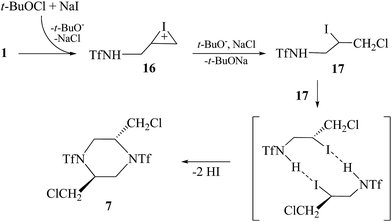 | ||
| Scheme 5 A tentative mechanism for the formation of (2R,5S)-2,5-bis(chloromethyl)-1,4-bis[(trifluoromethyl)sulfonyl]piperazine 7. | ||
Consideration of the structure of cation 17 allows to explain the X-ray structure with two axial CH2Cl substituents in the ring. Since the bond configuration around the triflamide nitrogens is planar, the adjacent chloromethyl groups adopt axial positions in the pre-formed six-membered ring after elimination of HI in order to minimize repulsions between the triflyl and chloromethyl substituents leading to the experimentally determined structure (Fig. 1).
The mechanism of formation of the bicyclic product 11 depends on the fate of diadduct 9 (Scheme 6). Route a suggests its cyclization to the intermediate N,N′-{[1,4-bis(trifluoromethylsulfonyl)piperazine-2,6-diyl]dimethanediyl}bis(triflamide) 18, which finally gives bicycle 11 by elimination of the triflamide molecule. An alternative route b is hardly possible since the two iodine atoms in the 8-membered cycle 10 are too far from each other being in the equatorial positions of the chair,chair-conformation of the 3,7-diiodo-1,5-bis[(trifluoromethyl)sulfonyl]-1,5-diazocane 10 molecule. Indeed, special experiment showed that compound 10 taken separately was not converted to bicycle 11 under the reaction conditions, via route b.
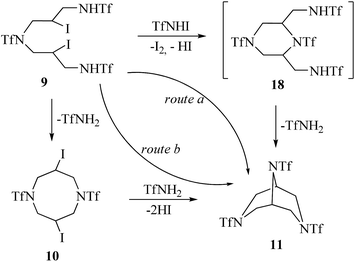 | ||
| Scheme 6 Possible routes to 3,7,9-tris[(trifluoromethyl)sulfonyl]-3,7,9-triazabicyclo[3.3.1]nonane 11. | ||
Conclusions
In summary, we have shown that unsaturated derivatives of triflamide, being involved as substrates in oxidative reactions with triflamide and arenesulfonamides in the system (t-BuOCl + NaI), give a series of new linear, cyclic and bicyclic products, whose structure depends on the reaction conditions and the nature of the reagents. With N-allyltriflamide, triflamide and arenesulfonamides show quite different reactivity patterns: bis-triflamidation in the former case and chlorination–dimerization in the latter. The reasons why triflamide enters the reactions of oxidative addition whereas arenesulfonamides and trifluoroacetamide act only as positive chlorine carriers are to be examined separately.Acknowledgements
All spectroscopic and X-ray measurements were performed on the equipment of the Baikal Center of Collective Use of Siberian Branch of the Russian Academy of Sciences.Notes and references
- B. Mathieu and L. Ghosez, Tetrahedron Lett., 1997, 38, 5497 CrossRef CAS.
- B. A. Shainyan and L. L. Tolstikova, Chem. Rev., 2013, 113, 699 CrossRef CAS PubMed.
- B. A. Shainyan and I. V. Ushakova, Russ. J. Org. Chem., 2012, 48, 141 CrossRef CAS.
- (a) B. A. Shainyan and Y. S. Danilevich, Russ. J. Org. Chem., 2015, 51, 601 CrossRef CAS; (b) B. A. Shainyan and Y. S. Danilevich, Russ. J. Org. Chem., 2013, 49, 922 CrossRef CAS; (c) B. A. Shainyan and Y. S. Danilevich, Russ. J. Org. Chem., 2013, 49, 1112 CrossRef CAS; (d) B. A. Shainyan and Y. S. Danilevich, Russ. J. Org. Chem., 2014, 50, 747 CrossRef CAS; (e) W. Zhang, N. Liu, C. M. Schienebeck, X. Zhou, I. I. Izhar, I. A. Guzei and W. Tang, Chem. Sci., 2013, 4, 2652 RSC; (f) B. A. Shainyan and I. V. Ushakova, Russ. J. Org. Chem., 2014, 50, 1835 CrossRef CAS; (g) B. A. Shainyan and I. V. Ushakova, Russ. J. Org. Chem., 2016, 52, 192 CrossRef CAS; (h) B. A. Shainyan, N. N. Chipanina, L. P. Oznobikhina and Y. S. Danilevich, J. Phys. Org. Chem., 2013, 26, 653 CrossRef CAS; (i) B. A. Shainyan, Y. S. Danilevich and I. A. Ushakov, Russ. J. Org. Chem., 2016, 52, 1112 CrossRef CAS; (j) B. A. Shainyan, I. V. Ushakova and Y. S. Danilevich, Russ. J. Org. Chem., 2015, 51, 931 CrossRef CAS; (k) B. A. Shainyan, V. I. Meshcheryakov and I. V. Sterkhova, Russ. J. Org. Chem., 2016, 52, 1032 CrossRef CAS; (l) B. A. Shainyan, N. N. Chipanina, L. P. Oznobikhina and V. I. Meshcheryakov, J. Phys. Org. Chem., 2017, 29, e3623 CrossRef.
- (a) M. Y. Moskalik, B. A. Shainyan and U. Schilde, Russ. J. Org. Chem., 2011, 47, 1271 CrossRef CAS; (b) M. Y. Moskalik, V. V. Astakhova, I. A. Ushakov and B. A. Shainyan, Russ. J. Org. Chem., 2014, 50, 445 CrossRef CAS; (c) I. V. Sterkhova, M. Y. Moskalik and B. A. Shainyan, Russ. J. Org. Chem., 2014, 50, 337 CrossRef CAS; (d) M. Y. Moskalik, B. A. Shainyan, V. V. Astakhova and U. Schilde, Tetrahedron, 2013, 69, 705 CrossRef CAS; (e) M. Y. Moskalik, V. V. Astakhova, U. Schilde, I. V. Sterkhova and B. A. Shainyan, Tetrahedron, 2014, 70, 8636 CrossRef CAS; (f) B. A. Shainyan, M. Y. Moskalik, V. V. Astakhova and U. Schilde, Tetrahedron, 2014, 70, 4547 CrossRef CAS; (g) V. V. Astakhova, M. Y. Moskalik, I. V. Sterkhova and B. A. Shainyan, Russ. J. Org. Chem., 2015, 51, 888 CrossRef CAS.
- (a) B. A. Shainyan, M. Y. Moskalik, V. V. Astakhova, I. V. Sterkhova and I. A. Ushakov, Tetrahedron, 2015, 71, 8669 CrossRef CAS; (b) V. V. Astakhova, M. Y. Moskalik, I. V. Sterkhova and B. A. Shainyan, Mendeleev Commun., 2017, 27, 293 CrossRef CAS.
- X. Liu, K. Tong, A. H. Zhang, R. X. Tan and S. Yu, Org. Chem. Front., 2017, 4, 1354 RSC.
- Crystallographic data were collected on a Bruker D8 Venture, μ (Mo Kα) = 0.7107 mm−1 at T = 100 K. All structures were solved and refined on F by using the SHELXS-2013 program. Crystal data for 7: C8H10Cl2F6N2O4S2, monoclinic, space group P21/c (no. 14), Z = 4, a = 8.8090(4) Å, b = 12.7998(6) Å, c = 7.2200(3) Å, β = 91.795(2)°, V = 813.68(6) Å3, Dc = 1.825 g cm−3; 2θmax = 60.1°; 21
![[thin space (1/6-em)]](https://www.rsc.org/images/entities/char_2009.gif) 282 reflections and 2381 with I > 2σ(I); 109 parameters (C, O, N, S, F, I, Cl anisotrope, H isotrope); maximum residual electron density 0.43 e Å−3; R1 = 0.026, wR2 = 0.064. Crystal data for 10: C8H10F6I2N2O4S2, monoclinic, space group P21/c (no. 14), Z = 8, a = 11.305(2) Å, b = 17.982(3) Å, c = 18.058(3) Å, β = 100.15(1)°, V = 3613.5(9) Å3, Dc = 2.316 g cm−3; 2θmax = 60.3°; 147
282 reflections and 2381 with I > 2σ(I); 109 parameters (C, O, N, S, F, I, Cl anisotrope, H isotrope); maximum residual electron density 0.43 e Å−3; R1 = 0.026, wR2 = 0.064. Crystal data for 10: C8H10F6I2N2O4S2, monoclinic, space group P21/c (no. 14), Z = 8, a = 11.305(2) Å, b = 17.982(3) Å, c = 18.058(3) Å, β = 100.15(1)°, V = 3613.5(9) Å3, Dc = 2.316 g cm−3; 2θmax = 60.3°; 147![[thin space (1/6-em)]](https://www.rsc.org/images/entities/char_2009.gif) 899 reflections and 10
899 reflections and 10![[thin space (1/6-em)]](https://www.rsc.org/images/entities/char_2009.gif) 609 with I > 2σ(I); 434 parameters (C, O, N, S, F, I anisotrope, H isotrope); maximum residual electron density 2.09 e Å−3; R1 = 0.043, wR2 = 0.089. Crystal data for 11: C9H10F9N3O6S3, triclinic, space group P
609 with I > 2σ(I); 434 parameters (C, O, N, S, F, I anisotrope, H isotrope); maximum residual electron density 2.09 e Å−3; R1 = 0.043, wR2 = 0.089. Crystal data for 11: C9H10F9N3O6S3, triclinic, space group P![[1 with combining macron]](https://www.rsc.org/images/entities/char_0031_0304.gif) (no. 2), Z = 4, a = 11.214(4) Å, b = 11.857(5) Å, c = 14.834(7) Å, α = 73.27(1)°, β = 78.95(1)°, γ = 80.98(1)°, V = 1848.0(1) Å3, Dc = 1.883 g cm−3; 2θmax = 60.2°; 40
(no. 2), Z = 4, a = 11.214(4) Å, b = 11.857(5) Å, c = 14.834(7) Å, α = 73.27(1)°, β = 78.95(1)°, γ = 80.98(1)°, V = 1848.0(1) Å3, Dc = 1.883 g cm−3; 2θmax = 60.2°; 40![[thin space (1/6-em)]](https://www.rsc.org/images/entities/char_2009.gif) 457 reflections and 9983 with I > 2σ(I); 541 parameters (C, O, N, S, F anisotrope, H isotrope); maximum residual electron density 1.48 e Å−3; R1 = 0.079, wR2 = 0.22.
457 reflections and 9983 with I > 2σ(I); 541 parameters (C, O, N, S, F anisotrope, H isotrope); maximum residual electron density 1.48 e Å−3; R1 = 0.079, wR2 = 0.22. - Selected bond distances (Å) for 7: C(2)–C(3) 1.527(2), C(3)–C(4) 1.528(2), C(2)–N(1) 1.480(1), C(3)–N(1) 1.482(1), C(4)–Cl(1), 1.785(1), C(1)–S(1) 1.8362(14), S(1)–O(1) 1.423(1), S(1)–N(1) 1.606(1), C(1)–F(1) 1.325(2).
- S. Minakata, Y. Morino, Y. Oderaotoshi and M. Komatsu, Org. Lett., 2006, 8, 3335 CrossRef CAS PubMed.
- Selected bond distances (Å) for 10: C(3)–C(4) 1.520(6), C(2)–C(4) 1.513(5), C(2)–N(2) 1.483(2), C(3)–N(1) 1.490(2), C(6)–C(7) 1.519(4), C(7)–C(8) 1.515(5), C(6)–N(1) 1.482(3), C(8)–N(2) 1.490(3), C(4)–I(1) 2.159(3), C(7)–I(2) 2.165(3). The I⋯I interatomic distance is 7.7 Å.
- Selected bond distances (Å) for 11: C(2)–C(3) 1.533(5), C(3)–C(4) 1.535(3), C(2)–N(1) 1.476(2), C(3)–N(3) 1.479(2), C(7)–C(8) 1.522(4), C(7)–C(9) 1.533(6), C(9)–N(1) 1.467(2), C(8)–N(2) 1.465(3), C(4)–N(2) 1.480(3), C(7)–N(3) 1.485(3).
- A. Tsutsui, T. Zako, T. Bu, Y. Yamaguchi, M. Maeda and K. Tanaka, Adv. Sci., 2016, 3, 1600082 CrossRef PubMed.
- A. R. Pradipta, A. Tsutsui, A. Ogura, S. Hanashima, Y. Yamaguchi, A. Kurbangalieva and K. Tanaka, Synlett, 2014, 25, 2442 CrossRef CAS.
- D. Reyx, B. Costes, L. Matějka and K. Dušek, Polym. Bull., 1988, 19, 269 CrossRef CAS.
- A. R. Pradipta and K. Tanaka, Heterocycles, 2013, 87, 2001 CrossRef CAS.
Footnote |
| † Electronic supplementary information (ESI) available: Detailed synthetic procedures, IR and NMR spectra of all new products, and X-ray structural analysis data. CCDC 1545539, 1520697 and 1520698. For ESI and crystallographic data in CIF or other electronic format see DOI: 10.1039/c7ra05831d |
| This journal is © The Royal Society of Chemistry 2017 |



